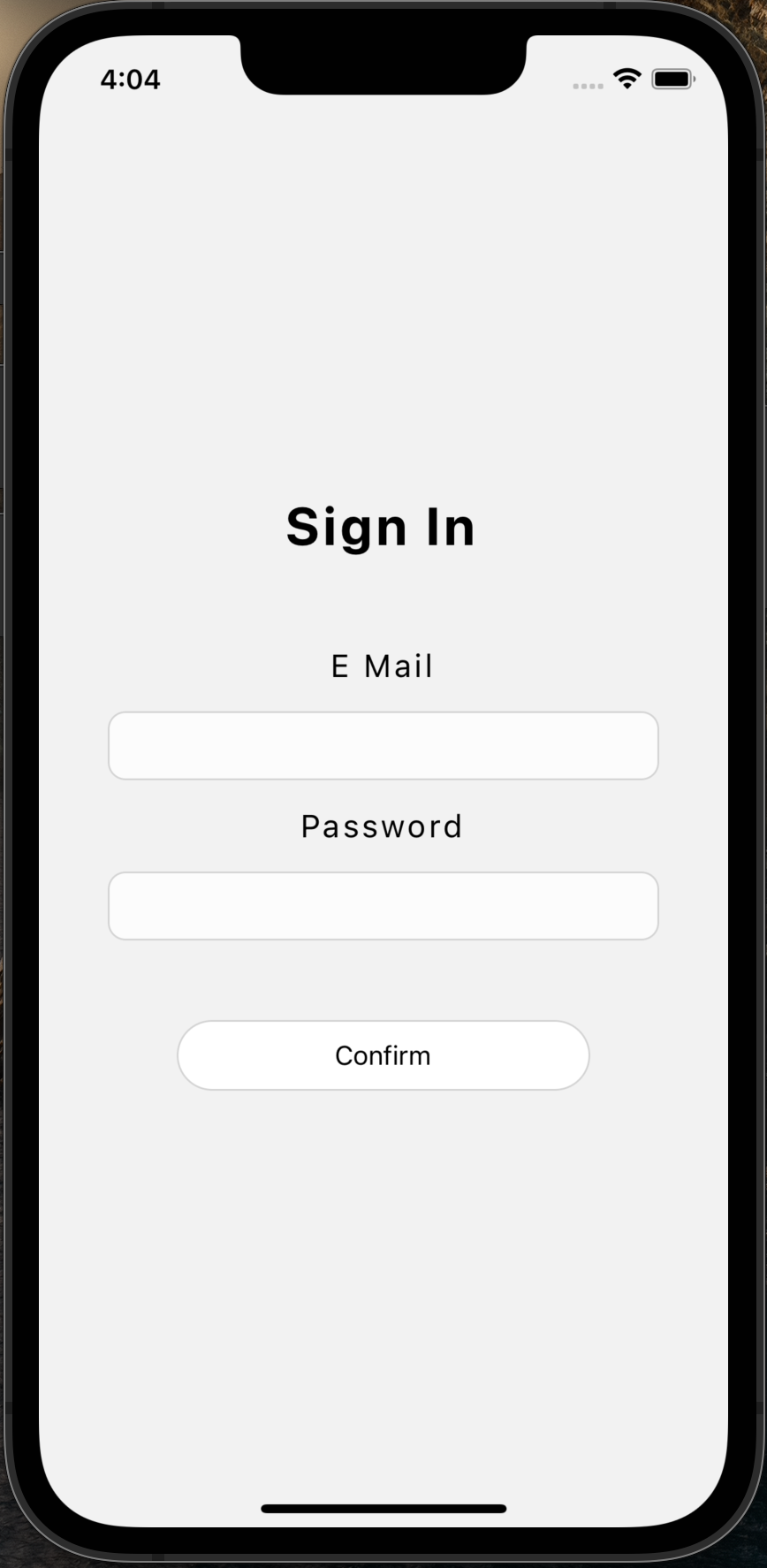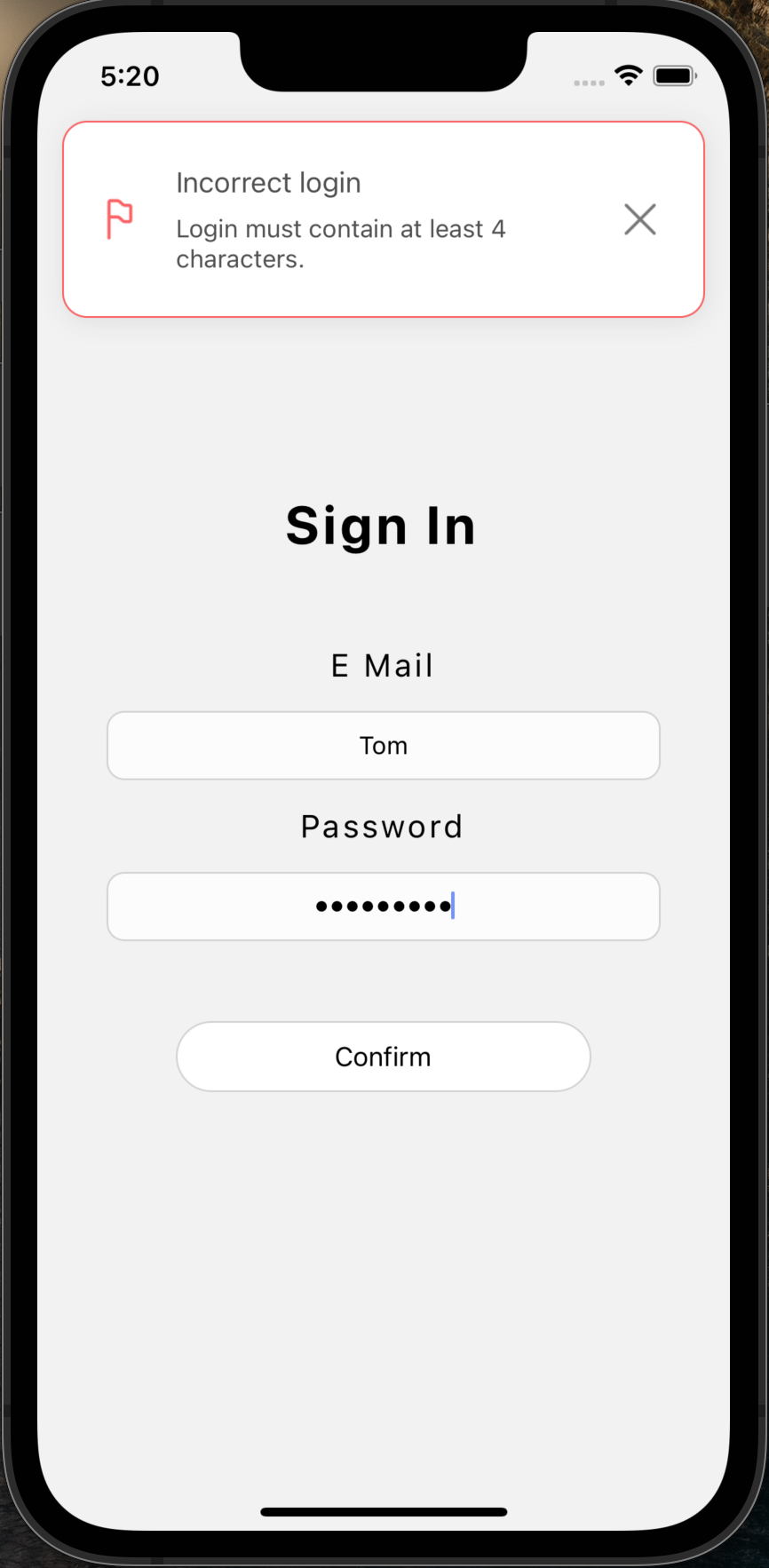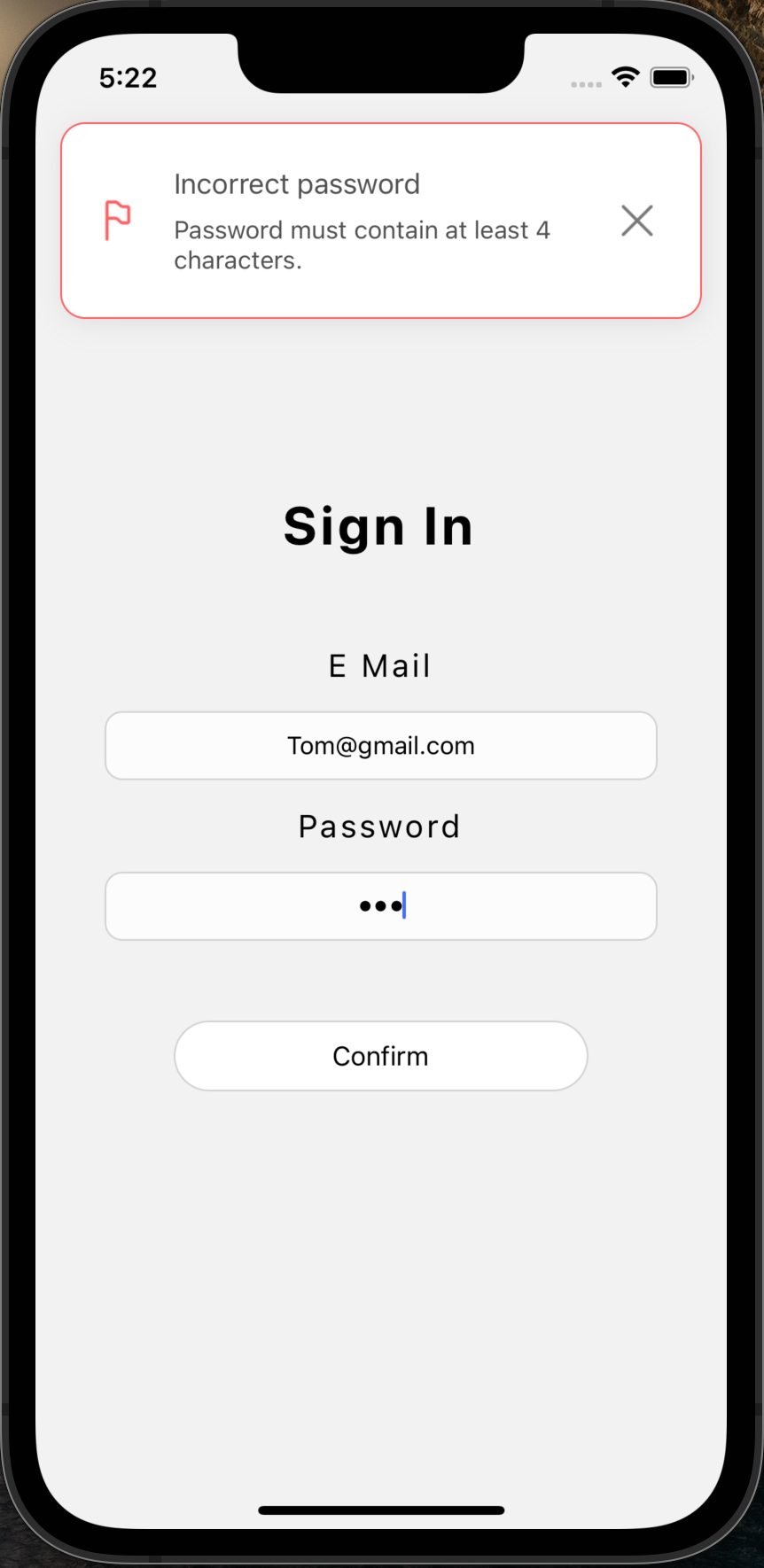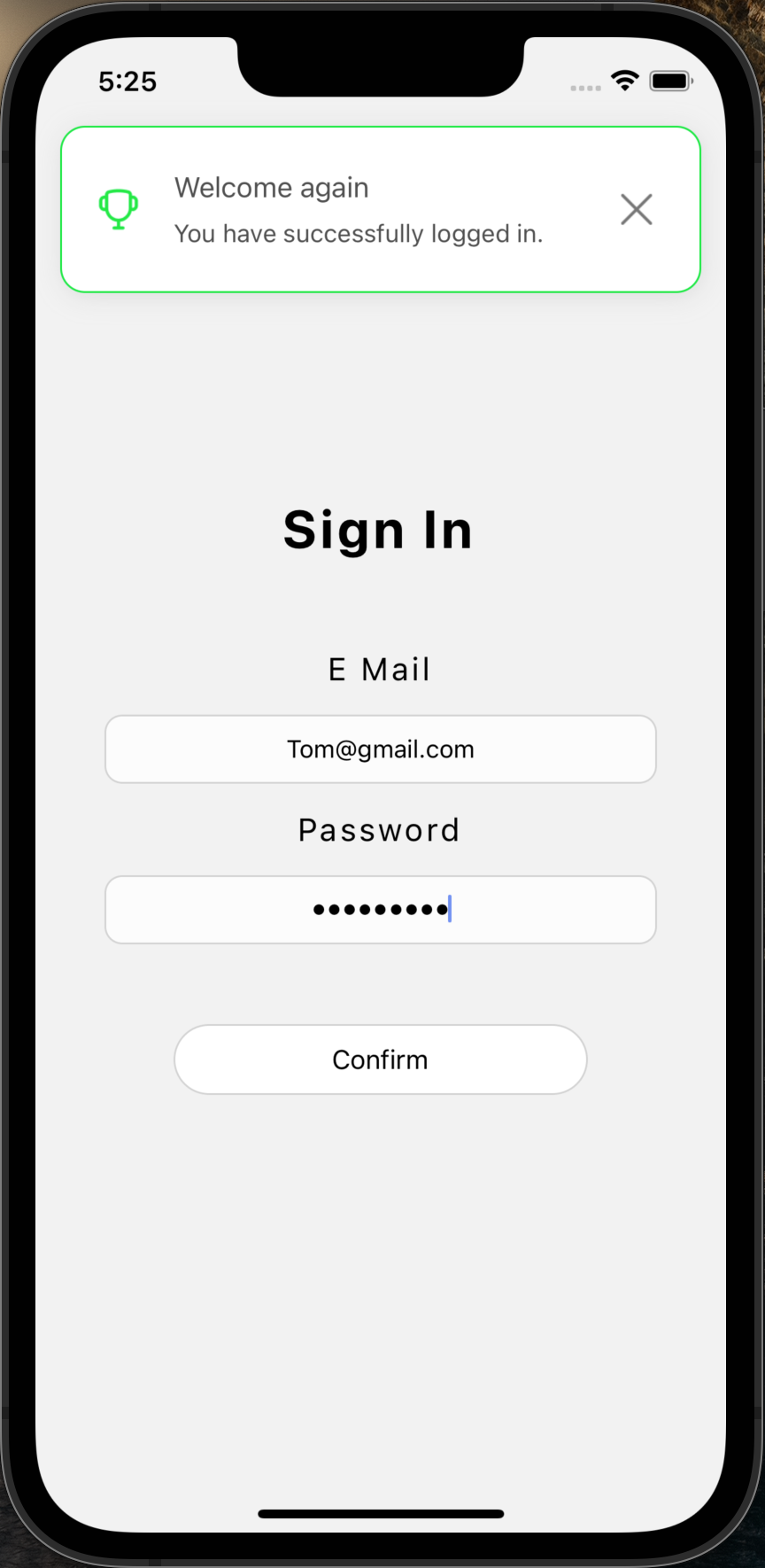🔥 Redux example
This example is quite different from the previous ones.
Our goal here is to show you how we can use RN Notifications library in real-life, in a more complicated environment.
For this reason, we built a dummy login screen.
In this example, we use the Redux Toolkit library.
Let's go step by step through it, and check where exactly notifications were triggered.
Redux Example component
import React from 'react'
import { store } from '../redux/store'
import { Provider } from 'react-redux'
import { LoginForm } from '../components/loginForm/LoginForm'
import { createNotifications } from 'react-native-notificated'
const { NotificationsProvider } = createNotifications({
isNotch: true,
})
export const ReduxExample = () => {
return (
<Provider store={store}>
<NotificationsProvider />
<LoginForm />
</Provider>
)
}
Redux Example is the main component, where we apply redux Provider, NotificationsProvider and render LoginForm component.
Let's check what happened here:
- we imported
React(of course),store(previously created), reduxProvider,LoginFormcomponent (previously created) and well knowncreateNotifications - we didn't pick
useNotificationshook. OnlycreateNotification, because we're not triggering notifications here - because
NotificationsProvideris applied on the same level asLoginFormwe have access to the notifications inside the form
Visualisation

Store
import { configureStore } from '@reduxjs/toolkit'
import formReducer from './reducers'
export const store = configureStore({
reducer: {
form: formReducer,
},
})
export type RootState = ReturnType<typeof store.getState>
export type AppDispatch = typeof store.dispatch
In the store.ts file, we:
- import
configureStorefunction, from@reduxjs/toolkit. That function is necessary to create the store. - import
formReducer(we will describe this function in the next paragraphs) - create
storewithconfigureStorefunction, and passformReduceras areducerthere, with a keyform - export two types:
RootStateandAppDispatchwhich we use to typeuseDispatchanduseSelectorhooks (we will come back to them soon)
Hooks
import { TypedUseSelectorHook, useDispatch, useSelector } from 'react-redux'
import type { RootState, AppDispatch } from './store'
export const useAppDispatch = () => useDispatch<AppDispatch>()
export const useAppSelector: TypedUseSelectorHook<RootState> = useSelector
We're now inside the hooks.ts.
Because we use typescript, we also want to type useDispatch and useSelector provided by Redux.
Thanks to that we received useAppDispatch function which is a typed useDispatch and useAppSelector which is typed useSelector
We will use them in the app, instead of using useDispatch and useSelector.
Reducers
This file (reducers.ts) is most important for us, because we use our notify() function here.
import { createSlice, Dispatch, PayloadAction } from '@reduxjs/toolkit'
import { notify } from '../components/loginForm/LoginForm'
type FormState = {
login: string
password: string
}
const initialState: FormState = {
login: '',
password: '',
}
export const formSlice = createSlice({
name: 'form',
initialState,
reducers: {
updateLogin: (state, action: PayloadAction<string>) => {
state.login = action.payload
},
updatePassword: (state, action: PayloadAction<string>) => {
state.password = action.payload
},
submit: (state) => {
if (state.login.length < 4) {
notify('error', {
params: {
title: 'Incorrect login',
description: 'Login must contain at least 4 characters. ',
style: {
multiline: 2,
},
},
})
}
if (state.password.length < 4) {
notify('error', {
params: {
title: 'Incorrect password',
description: 'Password must contain at least 4 characters. ',
style: {
multiline: 2,
},
},
})
}
notify('success', {
params: {
title: 'Welcome again',
description: 'You have successfully signed in. ',
style: {
multiline: 2,
},
},
})
},
},
})
export const { updateLogin, updatePassword, submit } = formSlice.actions
export default formSlice.reducer
export const fetchUsers = (dispatch: Dispatch) => {
setTimeout(() => dispatch(submit()), 2000)
}
In this file we:
- import function and types:
createSlice,Dispatch,PayloadActionfrom the@reduxjs/toolkit - and the
notify()function from theLoginFormcomponent. Why from there? In our opinion, it belongs there. We just want to use it in thereducers.tsfile, that's why we have imported it here - create the type for our
initialState(typeFormState), and createinitialStatewhich contains onlyloginandpassword, because it's all we need in our simple form - create
formSlicewhich contains our reducers:updateLogin,updatePasswordandsubmit.
TheupdateLoginand theupdatePasswordare just updaters, which are responsible for our state change, butsubmitis a function that sends our data to the backend (Of course, as we can see, it is not doing that. It's just making simple validation, and check if the login and the password have at least 4 characters but shhh ;) ).
If there is a problem with validation, ourerrornotifications are used. If everything is fine, we usesuccessnotification. - after that, we just export our reducer function and the reducer itself
- The last step is to create
fetchUsersfunction, which imitates the time we need to get a response from the backend. In fact, we just wrap oursubmithere
This is where we used our notify() function. Let's go to the last file: LoginForm where we use all of that.
Login Form
import React from 'react'
import {
NativeSyntheticEvent,
SafeAreaView,
Text,
TextInput,
TextInputChangeEventData,
TouchableOpacity,
View,
} from 'react-native'
import { fetchUsers, updateLogin, updatePassword } from '../../redux/reducers'
import { useAppDispatch, useAppSelector } from '../../redux/hooks'
import { styles } from './styles'
import { createNotifications } from 'react-native-notificated'
export const { notify } = createNotifications()
export const LoginForm = () => {
const login = useAppSelector((state) => state.form.login)
const password = useAppSelector((state) => state.form.password)
const dispatch = useAppDispatch()
const handleLoginChange = (e: NativeSyntheticEvent<TextInputChangeEventData>) => {
dispatch(updateLogin(e.nativeEvent.text))
}
const handlePasswordChange = (e: NativeSyntheticEvent<TextInputChangeEventData>) => {
dispatch(updatePassword(e.nativeEvent.text))
}
return (
<SafeAreaView style={styles.container}>
<Text style={styles.title}> Sign In </Text>
<View style={styles.form}>
<Text style={styles.label}>E Mail</Text>
<TextInput onChange={handleLoginChange} value={login} style={styles.input} />
<Text style={styles.label}>Password</Text>
<TextInput
onChange={handlePasswordChange}
value={password}
style={styles.input}
secureTextEntry
/>
<TouchableOpacity style={styles.button} onPress={() => fetchUsers(dispatch)}>
<Text style={styles.buttonText}>Confirm</Text>
</TouchableOpacity>
</View>
</SafeAreaView>
)
}
So again at the beginning, we need to import everything we need:
react nativecomponents and event- our reducers (please remember that
fetchUsersis in factsubmitwithsetTimeout) - our hooks, because we use them instead of
useDispatchanduseSelector - styles (previously prepared)
- and
createNotificationsto get access to thenotify()
After that we pick and export notify() (we're using it in the reducers.ts file).
Our LoginForm component consists of:
login(that we pull from the state)password(that we pull from the state)dispatchfunctionhandleLoginChangefunction (where we dispatchupdateLogin)handlePasswordChangefunction (where we dispatchupdatePassword)
In fact, that is all...
We need to pass the function to the inputs and the submit button.
Now let’s take a look at our notifications when we provide an invalid email or password vs. when we enter valid data.
Incorrect Login

Incorrect Password

You have successfully logged in
